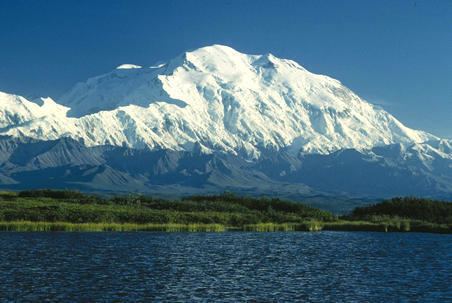 | ||
This article comprises three sortable tables of major mountain peaks of the U.S. State of Alaska.
Contents
The summit of a mountain or hill may be measured in three principal ways:
- The topographic elevation of a summit measures the height of the summit above a geodetic sea level. The first table below ranks the 100 highest major summits of Alaska by elevation.
- The topographic prominence of a summit is a measure of how high the summit rises above its surroundings. The second table below ranks the 100 most prominent summits of Alaska.
- The topographic isolation (or radius of dominance) of a summit measures how far the summit lies from its nearest point of equal elevation. The third table below ranks the 50 most isolated major summits of Alaska.
Highest major summits
Of the 100 highest major summits of Alaska, only Denali exceeds 6000 meters (19,685 feet) elevation, four peaks exceed 5000 meters (16,404 feet), 23 peaks exceed 4000 meters (13,123 feet), 61 peaks exceed 3000 meters (9843 feet), 92 peaks exceed 2000 meters (6562 feet), and all 100 peaks exceed 1740 meters (5709 feet) elevation. Five of these peaks lie on the international border with Yukon and five lie on the international border with British Columbia. All ten of the highest major summits of the United States are in Alaska.
Most prominent summits
Of the 100 most prominent summits of Alaska, only Denali exceeds 4000 meters (13,123 feet) of topographic prominence, six peaks exceed 3000 meters (9843 feet), 26 peaks exceed 2000 meters (6562 feet), 65 peaks are ultra-prominent summits with at least 1500 meters (4921 feet), and all 100 peaks exceed 1066 meters (3497 feet) of topographic prominence. Four of these peaks lie on the international border with British Columbia and four lie on the international border with Yukon.
Most isolated major summits
Of the 50 most isolated major summits of Alaska, only Denali exceeds 1000 kilometers (621 miles) of topographic isolation, four peaks exceed 500 kilometers (310.7 miles), 16 peaks exceed 200 kilometers (124.3 miles), 38 peaks exceed 100 kilometers (62.14 miles), and all 50 peaks exceed 71 kilometers (44.12 miles) of topographic isolation. Two of these peaks lie on the international border with British Columbia.
